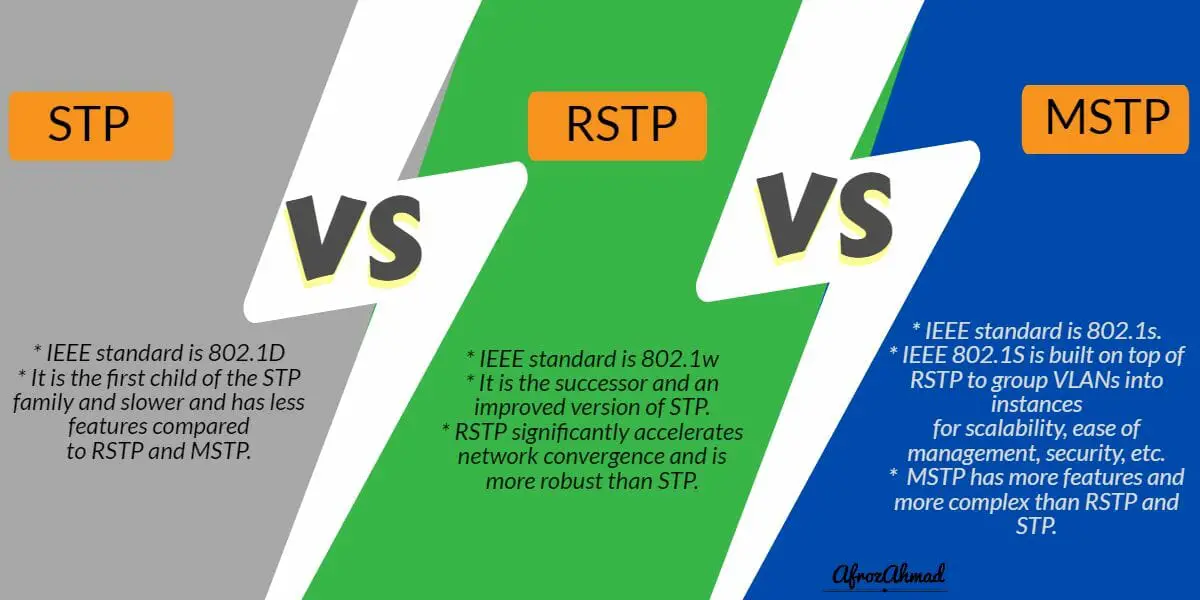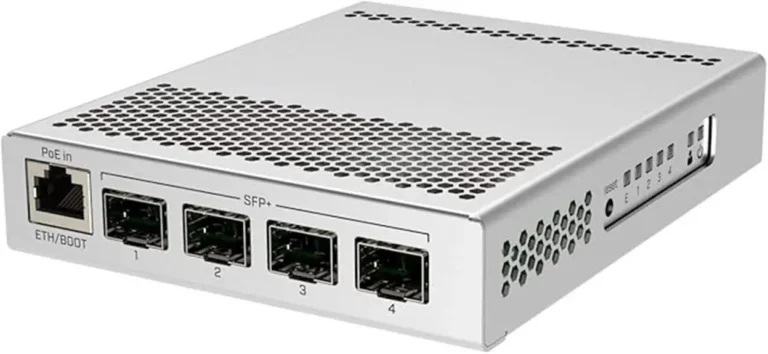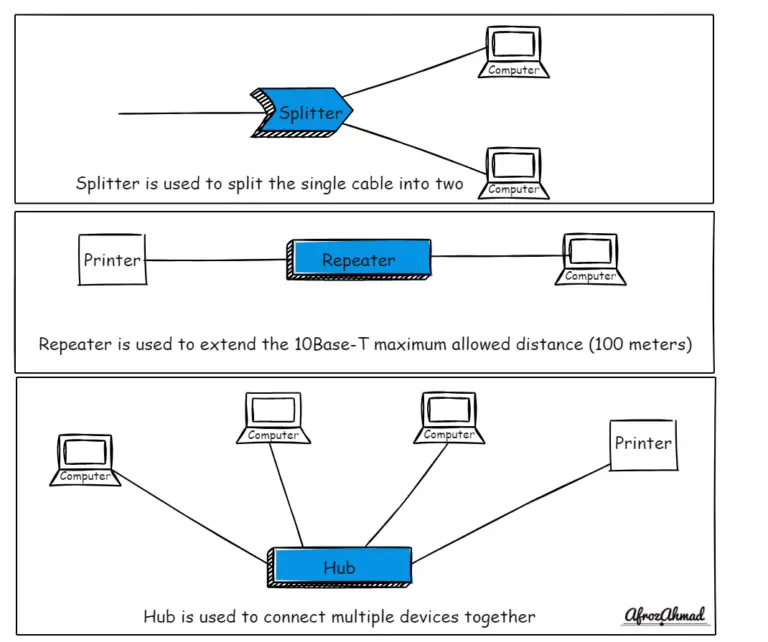Network redundancy is essential for maintaining network reliability, but it can lead to potential problems like broadcast storms and MAC address table instability if not properly managed. That’s where Spanning Tree Protocols come in. MSTP, RSTP, STP, PVSTP, and RPVST are different variants that each offer unique advantages in preventing loops and optimizing traffic flow.
RSTP is designed as an evolution of STP, offering faster convergence, while MSTP adds the ability to group VLANs into instances for more efficient management. PVSTP and RPVST, specific to Cisco devices, provide separate spanning-tree instances per VLAN for better load balancing.
Difference between MSTP vs RSTP vs STP
The most common types of Spanning Tree Protocol are MSTP, RSTP, STP, and PVSTP. They are all similar in that they prevent loops in a network, but there are some key differences.
STP IEEE 802.1D is the original Spanning Tree Protocol and is not as fast as RSTP, but it is still widely used.
Spanning Tree PVST Protocol (per VLAN STP) is a proprietary version of STP that is only compatible with Cisco equipment, as mentioned previously.
RSTP is a faster version of STP and is compatible with all other types. MSTP is the latest, and its primary function is to group VLANs into Instances. It is compatible with STP and RSTP. Let us dig deeper.
| STP | RSTP | MSTP | |
|---|---|---|---|
| 1 | Its IEEE standard is 802.1D. | Its IEEE standard is 802.1W. | Its IEEE standard is 802.1S. |
| 2 | IEEE 802.1D is the first child of the STP family. | IEEE 802.1W is the successor and an improved version of STP. | IEEE 802.1S is built on top of RSTP to group VLANs into instances for scalability, ease of management, security, etc. |
| 3 | STP results in slower network convergence and not so robust when compared to RSTP and MSTP. | On the other hand, RSTP significantly accelerates network convergence and is more robust than STP. | RSTP is the underlying protocol for MSTP, and that is why it also provides faster convergence similar to RSTP. But it has more features than RSTP. |
| 4 | Deployment of STP is more straightforward than RSTP and MSTP. | RSTP deployment is easier when compared to MSTP. | MSTP needs a proper understanding of STP and additional MSTP concepts before deployment. Which makes it harder to deploy and the reason sometimes network engineers opt for RSTP instead. |
| 5 | STP has three port functions:- Root Port Designated Port Blocked Port | RSTP utilises four ports:- Root Port Designated Port, Alternate Port Backup Port | MSTP has five-port roles:- Root Port Designated Port Alternate port, Backup Port Master port |
| 6 | STP supports five different port states:- Forwarding Learning Listening Blocking Disabled | RSTP is composed of three-port states:- Forwarding Learning Discarding (It replaces Forwarding, Learning, and Listening for fast convergence.) | Since MSTP is built on top of RSTP, it has the same three port states:- Forwarding Learning Discarding |
| 7 | It lacks all link types. | It supports two types of links: shared links and point-to-point links. | It also has two link types, i.e., Shared link and Point to point link. |
| 8 | STP use only 2 bits from the flag octet: Bit 7: Topology Change Acknowledgment. Bit 0: Topology Change | In RSTP, the following flag bits are used: Bit 0 for TCN Bit 1 for Proposal Bits 2 and 3 for Port role Bit 4 for Learning Bit 5 for forwarding Bit 6 for Agreement Bit 7 for TCN | Same as RSTP. |
| 9 | In STP, the root bridge is the only one that sends BPDUs. Others then transfer BPDUs (Bridge protocol data units). | All bridges in RSTP are capable of forwarding BPDUs. | In MSTP, all bridges can forward BPDUs. |
| 10 | In the Spanning Tree Protocol, when a bridge detects a change in the network, it notifies the root, who then notifies all others via BPDU with the TCA bit set, instructing them to clear their database entries when the "short-timer" (Forward delay) expires. | In RSTP, TC (Topology change) is flooded throughout the network; each bridge generates TC (Topology change) and notifies its neighbors when a topology change occurs, immediately deleting old database entries. | Same as RSTP. |
| 11 | If a non-root bridge does not receive Hello after 10*Hello (advertised from the root), the non-root bridge should begin claiming the root role by generating its own Hello. | On the other hand, RSTP does not act until it receives 3*Hello on a root port (advertised from the root). | Same as RSTP. |
| 12 | STP waits until all TC have reached the root and the short timer (Forward delay) has expired before flashing all root database entries. | RSTP immediately deletes all local databases except for the MAC of the port receiving the topology changes (proposal) | Same as RSTP. |
| 13 | STP is compatible with RSTP and MSTP. But it is always advisable to check with the device vendor before deploying more than one Spanning tree Protocol type in your network. | Rapid Spanning Tree Protocol is backward compatible with STP. | MSTP has CST (Common Spanning Tree) Instance, which is backward compatible with the RSTP and STP. |
| 14 | Load balancing or utilizing multiple physical paths in the network is not possible with STP. All VLANs have to follow the same Spanning Tree path. | Same as STP. | Contrary to STP and RSTP, with MSTP, you can group VLANs into separate MST Instances and can utilize multiple physical paths. |
| 15 | Ports connected to endpoints (laptops, computers, printers, etc.) cannot be configured as an edge port for fast transition. There is no concept of edge ports in STP. | When connected to endpoints while in RSTP, these ports can be configured as edge, ports to allow for rapid changes in the forwarding state. | Boundary ports are ports at the edge of an MST region that are connected to either an STP or RSTP bridge or an endpoint. |
What is PVSTP and RPVST? – PVST vs Rapid PVST
Spanning Tree PVST Protocol (per VLAN STP) or Rapid PVST are Cisco proprietary Spanning Tree Protocols and are only compatible with Cisco equipment. PVST and RPVST allow for multiple spanning tree instances, providing more efficient load balancing compared to the single spanning tree instance in the standard 802.1D protocol.
The key differences are:
- PVSTP (Per VLAN Spanning Tree Plus)
- Creates a separate spanning tree instance for each VLAN.
- Supported on ISL trunks.
- Slower convergence than RPVST.
- RPVST (Rapid Per VLAN Spanning Tree Plus)
- Also creates a separate spanning tree instance per VLAN.
- Supported on 802.1Q trunks.
- Faster convergence than PVSTP.
- Has 4 port states like MSTP.
The main advantages of having multiple spanning tree instances with PVSTP/RPVST compared to the single instance with 802.1D are:
- More optimal traffic forwarding as each VLAN can have its own root bridge. This enables better load balancing across links.
- If there is a topology change for one VLAN, it does not affect other VLAN spanning trees, providing faster convergence.
The disadvantage is that more CPU and memory resources are consumed with multiple spanning tree instances. PVSTP and RPVST are proprietary to Cisco devices, whereas MSTP is an IEEE standard for multiple spanning trees.
What are PVSTP, PVSTP+, and RPVSTP, and what is the difference between the IEEE versions of STP?
The IEEE Spanning Tree Protocol (STP) was developed to provide a standard way of creating a loop-free topology for Ethernet networks. Before STP was published, many vendors who sold VLAN-capable switches developed versions of STP that were compatible with their products. Cisco also developed proprietary versions of STP called PVSTP, PVSTP+, and RPVSTP.
Per-VLAN Spanning Tree (PVST) is developed by Cisco and uses Cisco’s proprietary ISL (Inter-Switch Link) for VLAN encapsulation, while PVST+ uses 802.1Q for VLAN encapsulation. It is important to note that PVST is obsolete, and PVSTP+ is mainly used on Cisco switches.
RPVST is a faster and enhanced form of PVSTP+ and creates a separate spanning tree for each VLAN, similar to PVST.
Conclusion
To wrap up, understanding the nuances between MSTP vs RSTP vs STP vs PVSTP vs RPVST is crucial for any network engineer looking to optimize their network’s performance and reliability. Each protocol serves a distinct purpose, designed to prevent loops and enhance network efficiency in various environments.
MSTP offers advanced features for grouping VLANs, while RSTP provides faster convergence. PVSTP and RPVST, specific to Cisco, allow for more detailed traffic management across VLANs. By choosing the right protocol for your network, you ensure smoother operations and future-proof your infrastructure against potential issues. This guide has laid the groundwork, equipping you with the knowledge to make an informed decision tailored to your network’s unique demands.
- Telecom Network Infrastructure: Complete Guide to Components & Design - January 6, 2026
- TP-Link TL-SG108E vs Netgear GS308E: Budget Smart Switches - January 5, 2026
- MikroTik CRS305-1G-4S+ Review: The Ultimate Budget SFP+ Switch Guide - December 25, 2025





